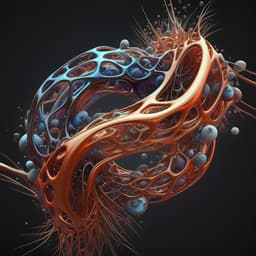
Physics
Rich nature of Van Hove singularities in Kagome superconductor CsV3Sb5
Y. Hu, X. Wu, et al.
Explore how the layered kagome metals AV3Sb5 showcase an intriguing interplay of correlated phenomena and topological electronic structures, as revealed through advanced spectroscopy and theory by a collaborative team including Yong Hu and Xianxin Wu.
~3 min • Beginner • English
Introduction
Transition-metal kagome materials host geometric frustration, flat bands, Dirac cones, and van Hove singularities (VHSs) that can drive unconventional phenomena such as correlated orders, topology, and superconductivity. In the kagome metals AV3Sb5 (A = K, Rb, Cs), a Z2-topological band structure, superconductivity (Tc up to 2.5 K), and charge-density-wave (CDW) order (TCDW ~78–103 K) have been reported, alongside signatures of additional symmetry breaking and possible unconventional superconductivity. Because VHSs near the Fermi level enhance the density of states and interaction effects, clarifying their dispersion (conventional vs higher-order) and sublattice nature (sublattice-pure p-type vs sublattice-mixed m-type) is pivotal to understand instabilities such as CDW, nematicity, and superconductivity. This study aims to determine the nature (order, orbital content, and sublattice character) of the VHSs and related Dirac cones in CsV3Sb5 using polarization-dependent ARPES corroborated by DFT.
Literature Review
Prior work established kagome systems as a platform for correlated and topological physics, including Dirac/Weyl semimetals and potential spin liquids. In AV3Sb5, discoveries include nontrivial topology, superconductivity, CDW order, and possible time-reversal and rotational symmetry breaking. Theoretical studies classify VHSs by dispersion (conventional vs higher-order) and by sublattice character (p-type vs m-type), with higher-order VHSs expected to yield power-law DOS divergences and distinct instabilities, and p-type VHSs predicted to suppress local Hubbard interactions via sublattice interference, enhancing non-local interactions. Previous experiments (transport, thermodynamics, STM) suggested unconventional superconductivity and complex CDW, motivating direct momentum-resolved and symmetry-resolved probes of the VHSs and Dirac cones.
Methodology
Samples: Single crystals of CsV3Sb5 were grown by self-flux in an argon glovebox. A precursor mixture of 50 at.% Cs0.4Sb and 50 at.% VSb2 (with vanadium powder pre-purified) was ball-milled 60 min in a tungsten carbide vial, sealed in alumina crucibles/jackets under argon, heated to 1000 °C (250 °C/h) for 24 h, cooled to 900 °C (100 °C/h), then slowly cooled to 500 °C at 1 °C/h before terminating growth. Crystals were recovered mechanically; composition was checked by EDS.
ARPES: Samples were cleaved in situ (base pressure < 5 × 10−11 Torr). ARPES was performed at the ULTRA endstation of the SIS beamline (Swiss Light Source) with a Scienta-Omicron DA30L analyzer, using mainly 78 eV photons and total energy resolution of 18 meV. Fermi level was referenced to a polycrystalline Au. Polarization-dependent geometries (circular, linear horizontal LH, linear vertical LV) were employed along Γ–K–M–K and Γ–M–Γ cuts to apply matrix-element selection rules and assign orbital parities relative to the mirror plane.
DFT: First-principles calculations were performed using VASP with PAW and GGA-PBE, plane-wave cutoff 500 eV, and a 9 × 9 × 5 Monkhorst-Pack k-mesh. Spin–orbit coupling was tested and found to introduce gaps without qualitative changes to orbital characters; main-text bands are shown without SOC for clarity. Experimental crystal structure (space group P6/mmm; a = b = 5.4949 Å, c = 9.3085 Å) was used. Orbital- and sublattice-resolved analyses and irreducible representations at M were obtained to classify VHSs (p-type vs m-type) and their symmetries.
Key Findings
- Four VHSs (VHS1–VHS4) occur at the M point near the Fermi level in CsV3Sb5.
- Three VHSs (VHS1–VHS3) lie below EF and are formed by V 3d orbitals; one (VHS4) lies slightly above EF (from DFT).
- Dispersion types:
• VHS1 exhibits an extremely flat dispersion along M–K with suppressed quadratic term and dominant quartic term, establishing a higher-order VHS experimentally; its measured flatness exceeds DFT, indicating correlation-induced renormalization.
• VHS2 and VHS3 are conventional VHSs with quadratic dispersions in both orthogonal directions.
• VHS4 (above EF, not observed by ARPES) is conventional by DFT.
- Sublattice/orbital character (from polarization-dependent ARPES and DFT):
• VHS1: p-type (sublattice-pure), inversion-even (Ag), predominantly d_yz.
• VHS2: p-type (sublattice-pure), inversion-even (B2g), predominantly d_xz.
• VHS3: p-type (sublattice-pure), inversion-even (B1g), predominantly d_xy.
• VHS4: m-type (sublattice-mixed), inversion-odd (B1), predominantly d_xz, with mixed B and C sublattice contributions, slightly above EF.
- Dirac cone at K (binding energy ~−0.27 eV) shows strong polarization-dependent intensity modulations that reverse above vs below the Dirac point and swap between LH and LV geometries. Simulations based on sublattice interference reproduce these patterns, evidencing chiral, kagome-derived Dirac fermions and embedded sublattice interference.
- Weak kz dispersion is observed for V d-orbitals; CDW influences bands near M at low temperature, but main analyses were conducted at 200 K.
Discussion
By directly resolving the dispersion order, orbital content, and sublattice nature of the VHSs, the work establishes that CsV3Sb5 hosts multiple p-type VHSs near EF, including a higher-order VHS with a remarkably flat M–K dispersion, and an m-type VHS just above EF. The p-type sublattice texture suppresses local Hubbard interactions via sublattice interference and enhances the role of non-local Coulomb terms, shaping the hierarchy of electronic instabilities. Conventional p-type VHS2 possesses favorable Fermi-surface nesting connecting different sublattices, consistent with a 2 × 2 bond CDW tendency observed in AV3Sb5. In contrast, the higher-order p-type VHS1 exhibits weak nesting but large DOS, which can promote nematicity and account for additional rotational symmetry breaking in the CDW phase. The coexistence of p- and m-type VHSs from multi-orbital bands implies a rich competition among pairing and density-wave instabilities sensitive to small changes in filling, consistent with pressure/doping-tunable phase diagrams. The observed sublattice-interference signatures and chirality in the Dirac cones further confirm that sublattice degrees of freedom are imprinted across the kagome Fermiology, impacting selection rules and interaction channels.
Conclusion
Polarization-dependent ARPES combined with DFT reveals four V 3d-orbital VHSs at M in CsV3Sb5: three p-type below EF (with VHS1 being higher-order and extremely flat along M–K) and one conventional m-type slightly above EF. The Dirac cones at K display pronounced, polarization-dependent intensity modulations consistent with sublattice interference and chirality. These results provide a microscopic foundation for understanding correlated orders in AV3Sb5, including CDW, nematicity, and unconventional superconductivity driven by enhanced DOS and sublattice textures at VHSs. Future work should (i) directly access the unoccupied m-type VHS (e.g., via pump–probe ARPES), (ii) study temperature and CDW-phase evolution with finer momentum/energy resolution, (iii) quantify correlation-induced renormalizations and SOC effects, and (iv) tune filling via doping or pressure to map instability competition and superconducting pairing symmetry.
Limitations
The m-type VHS above EF was identified by DFT but not directly observed by ARPES due to its unoccupied energy. Matrix-element effects in ARPES suppress intensity for specific polarizations and photon energies (e.g., reduced VHS1 flat-top intensity at 78 eV), requiring multi-energy measurements. Analyses were primarily performed at 200 K; although CDW influences bands near M at lower temperatures, comprehensive temperature-dependent ARPES across the CDW transition is outside the main scope. DFT results shown without SOC for clarity, and correlation-induced band renormalizations imply quantitative differences between experiment and theory. kz dispersion is weak but nonzero for some features.
Related Publications
Explore these studies to deepen your understanding of the subject.







